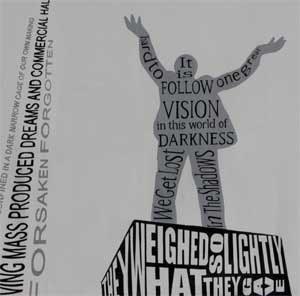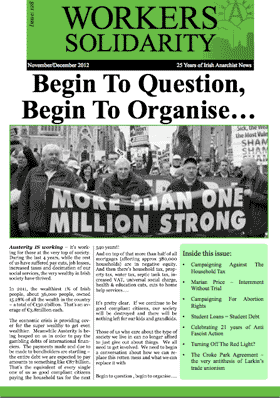Over 30 years of anarchist writing from Ireland listed under hundreds of topics
The Croke Park Agreement – the very antithesis of Larkin’s trade unionism
 Next year, 2013, will mark the 100th anniversary of what many see as the most significant industrial dispute ever to have taken place in Ireland - the Dublin Lockout. The employers of Dublin, led by William Martin Murphy, locked out over 20,000 workers in an attempt to starve them into submission and to smash the increasingly popular Irish Transport and General Workers Union (ITGWU).
Next year, 2013, will mark the 100th anniversary of what many see as the most significant industrial dispute ever to have taken place in Ireland - the Dublin Lockout. The employers of Dublin, led by William Martin Murphy, locked out over 20,000 workers in an attempt to starve them into submission and to smash the increasingly popular Irish Transport and General Workers Union (ITGWU).
The ITGWU, founded in 1908, had been built on the basis of the sympathetic strike with the principle of the strongest groups of workers taking action to protect the weakest at its core. The almost 5 months from the end of August 1913 to mid-January 2014 saw a determined effort by Dublin’s employers to break the ITGWU and to smash the idea of workers’ unity and solidarity. And while the strike ended in defeat, it is still seen as a hugely significant event in the history of Irish trade unionism.
It is ironic that many of those – union leaders and members alike – who will participate in events to commemorate the centenary of the lockout next year have, over the last couple of years, been part of a trade union movement that in many ways has come to stand for the total opposite of the idea of the strongest protecting the weakest.
The Croke Park Agreement (CPA), when it was put to a ballot of public sector union members in the first half of 2010, came on the back of a 12 - 15% pay cut for all public servants (between both a direct pay cut and the imposition of a pension levy). It was sold to union members by its proponents – which included the vast majority of the union leadership – as the only way in which wages and conditions could be protected in the face of a cacophony of voices screaming for ‘public sector reform’ and heaping the blame for the financial crisis on a ‘bloated’, ‘overpaid’, public sector.
The reality of course was completely different. Then, as now, the vast majority of public servants were on low to middle incomes. In 2011, when the effect of the pension levy is taken onto account, 60% of public sector workers earned €45,000 per year or less before tax.
The legacy of ‘partnership’
The debate on the CPA came after 20 years of so-called ‘social partnership’ which had blunted the trade union movement, leaving it with a whole generation of officials who only knew the language of ‘partnership’.
Similarly, a generation of union members did not see the union as being a collective which fought to protect and improve working conditions and pay rates. A divide had emerged whereby most union members were more likely to ask ‘what’s the union doing about X, Y or Z?’ rather than seeing themselves as an integral part of a body which should not alone be defending their own rights but also looking to defend those of other, less organised groups of workers. ‘The union’ was often seen as an insurance policy, a way of accessing cheaper life insurance and various group discount deals.
So when the economic collapse came and with it the outright assault on wages and working conditions, the vast majority of both union officials and union members had no concept of a way in which this assault could be dealt with other than through some sort of ‘partnership’ deal. The idea that we all as workers had (and have) the collective power to impose our will and to resist these attacks, the idea that we are strong together and that the unions were originally built on the principle of being able to withdraw our labour in order to demonstrate our strength had been lost for many.
And so the union leadership (who had no other vision of what a union should be) were able to sell to the union membership the Croke Park Agreement, saying clearly at the time that it was a rotten deal but ‘threatening’ that without it we would be powerless to stop further attacks on our wages and working conditions.
Those of us who opposed the CPA attempted to outline an alternative vision of what a union movement should consist of, and advocated a belief that it was only by rejecting this deal and building a fighting movement that we could hope to protect both our wages and conditions and the integrity of the public services we worked in – education, health, social welfare…. We also pointed out forcibly that the document referred constantly to ‘existing public servants’ and appealed to union members not to sacrifice the wages and terms and conditions of young people likely to join the public service in the following years in the hope of protecting our own.
‘Told you so’
There is very little joy or satisfaction in being able to say ‘told you so’ but the sad reality is that the last 2 and a bit years of the CPA have seen exactly that happen – the working conditions and pay rates of ‘new entrants’ to the public service have been savaged, and the services themselves have been slashed.
Nowhere is this more obvious than in the teaching profession. This is because teaching is one of the few areas of the public service where there is any recruitment. In all other areas the recruitment embargo has meant there are few if any ‘new entrants’. But what is currently happening to Newly Qualified Teachers (NQTs) will be replicated all across the civil and public service in the next couple of years. The figures are stark and frightening. In 2008 a primary teacher starting out took home €557 per week after tax and other deductions, in September 2012 a starting teacher’s net take home pay was just €406 – that’s a reduction of almost 28%.
This has happened with hardly a murmur from the teaching unions – either leadership or members. Yes there have been a few strongly worded statements, but there has been no action or even threatened protests. Newly Qualified Teachers – the weakest in terms of today’s teacher unions - rightly feel that the principle of the strongest protecting the weakest has been ditched by today’s trade unions.
It’s not as if trade union leaders don’t have an alternative economic strategy. The ICTU, TASC (http://tascnet.ie/ ) and the Nevin Economic Research Institute (http://www.nerinstitute.net/ ) have all produced alternative economic strategies. These may not be revolutionary but they do show that there is ‘another way’. But trade union leaders appear to have completely accepted the mantra of government and mainstream commentators – that politically There Is No Alternative (TINA). They do not appear to have any faith or hope that union members could be won away from the ‘truth’ that public spending must be slashed to pay off the gambling debts run up by international financiers and developers. Indeed they appear unwilling to even engage union members in that discussion.
Acceptance of this ‘truth’ leaves them fearful of fighting any proposed cut to services – or the pay cuts for new entrants - because this might result in pay being targeted for cuts instead. And they see the CPA as providing protection against pay cuts.
Having peddled the CPA through the fear factor, the union leaders’ mantra now is that members don’t want to know about fighting cuts to services, or about taking action to protect the pay of new entrants. And there is no doubt a large degree of truth to this. Coming off the back of 20 years of ‘social partnership’, having been sold the CPA as ‘the only way possible way to protect wages’ and having the fear factor blasted at them daily from supposedly ‘independent’ commentators it’s hardly a surprise that union members are reluctant to take any action.
Ignoring the obvious
Unfortunately though, union members who are keeping their heads down and hoping that the CPA will protect them are the equivalent of people who refuse to heed a hurricane warning in the hope that by pretending it’s not there nothing bad will happen. While they are keeping their heads down, the very foundation they are standing on is being destabilised under their feet.
The services in which they work – be it education, health, social welfare – are suffering attack after attack. People are constantly being told that the ‘reality’ is they must ‘do more with less’. And most worryingly, people entering the job are being paid a fraction of what has been fought for over the years.
If today’s union members do not feel they should take action to protect their weaker colleagues (the basis on which trade unionism has been built), pure self-interest should be enough to make them take what is being dome to their younger colleagues more seriously.
After all, does anyone honestly think that in the post-CPA world (it’s due to expire in early 2014) the pressure won’t come on immediately to reduce all wages in line with the pay rates of ‘new entrants’? Commentators are already gearing up for the next phase of the onslaught and already it is possible to hear the statements about ‘greedy’ teachers ‘creaming it in’ while their younger colleagues suffer on lower pay scales.
Collective solidarity
In conclusion therefore, the CPA must be seen as the very antithesis of what real trade unionism should be about. Trade unionists who want to truly commemorate the spirit and courage of those who took to the streets in 1913 must first of all ditch the current strategy of appeasement and acceptance of the attacks on our living standards and our services. We need to re-forge the real soul of our trade unions as bodies based on collective solidarity. We need, in short, more than fine words about Jim Larkin and his colleagues, we need to re-discover some of the fighting spirit and sense of solidarity which Dublin’s workers in 1913 had in abundance.
WORDS: District 14 Irish National Teachers Organisation (personal capacity), Gregor Kerr - Chair
A shorter version of this article appeared in
Workers Solidarity 128 - Nov/Dec 2012


